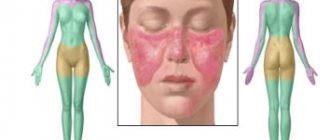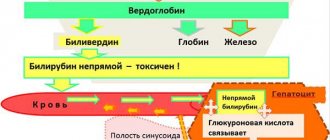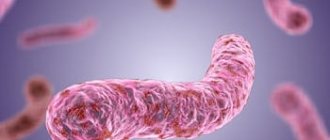Hemophilia is a hereditary disease characterized by increased bleeding. The disease is associated with a deficiency in the blood plasma of a factor necessary for the clotting process (coagulation). Even with minor injuries, blood flows from wounds for a long time.
Hemophilia is a disease of men; women do not suffer from this disease. They are only a carrier of the hemophilia gene, and no signs of the disease are observed in carriers of the disease.
The genes that are responsible for the development of the disease are linked to the sex X chromosome. The disease is inherited through the female line.
In 50% of cases, a woman who is a carrier of the hemophilia gene gives birth to a sick boy. The hereditary defect is transmitted through an apparently healthy mother. A healthy father and a carrier mother are equally likely to give birth to both a healthy and a sick child.
In a man with hemophilia, the sons do not inherit the coagulation disorder and their offspring do not inherit the disease. Daughters, on the contrary, while remaining healthy themselves, pass hemophilia to their offspring.
Congenital hemophilia accounts for 70% of all cases of the disease. Patients inherit the form and severity of the disease.
Signs of hemophilia
Signs of the disease appear in early childhood. With age, bleeding symptoms become less pronounced. Hemophilia is a dangerous genetic disease.
In patients, bleeding develops at the time when the boy begins to learn to walk. Household injuries and bruises cause large subcutaneous, intramuscular and intra-articular hemorrhages.
In rare cases, hemophilia appears in infancy. Bruises appear from the slightest pressure on the skin. Boys who suffer from hemophilia have thin, pale skin and practically no subcutaneous fat develops. Boys have such a fragile appearance, it seems that if you touch them they can crumble.
What is hemophilia
Hemophilia is a congenital disorder of the blood coagulation system. From birth, patients with hemophilia lack (or are present in extremely small quantities) special proteins responsible for blood clotting - clotting factors.
Hemophilia is a hereditary disease that affects only men, although women are carriers of the defective gene. Coagulation disorders are caused by a lack of a number of plasma factors that form active thromboplastin. More often than others, antihemophilic globulin is missing. The cause of hemophilia is the presence of a “bad” mutation in the sex X chromosome.
This means that there is a certain section (gene) on the X chromosome that causes such a pathology. This altered gene on the X chromosome is the actual mutation (recessive). Due to the fact that the mutation is located on the chromosome, hemophilia is inherited, that is, from parents to children.
Dangers of the disease
Photo: Social networks
The reason that caused the bleeding may be insignificant, but the blood loss becomes life-threatening. Hemophilia has different forms, some of them are characterized by a relatively mild course. At a later age, they are detected and manifest strongly.
Hemorrhages into the cavity of large joints (knees and ankles) cause severe changes in them. Patients experience joint deformation and limited mobility. Possible increase in body temperature.
In severe forms of hemophilia, signs of bleeding appear early. A child may even bleed from the mucous membrane of the mouth. At the age of one to three years, signs of damage to muscle tissue and joints may appear. Painful swelling occurs and limb movement is limited.
Patients with hemophilia often receive transfusions of blood components. As a result, a person can be infected with hepatitis B, C, D, or HIV infection. A mild form of hemophilia does not affect a person's life expectancy. In severe cases, the prognosis is not so optimistic. Massive bleeding after injuries and operations can be fatal.
Intramuscular injections can cause extensive internal hematomas in a child.
Complications
Rice. 1. X-ray of the lower third of the thigh and upper third of the leg of a patient with hemophilia. Pathological fracture of the fibula in the area of the cyst.
In cases of mild and moderate severity, complications rarely occur. Repeated hemorrhages into the joint cause thickening of the capsule, narrowing of the cartilage and osteoporosis. With hemorrhages in the knee joint, which is more often affected, blood accumulates in the superior inversion, causing severe pain and secondary reflex atrophy of the quadriceps muscle. If left untreated, persistent contracture develops. The formation of blood cysts in the metaphysis, less often in the diaphysis of tubular bones, is characteristic. Sometimes cysts are localized in the pelvic and heel bones. The presence of destructive processes in the bones often leads to patol, fractures (Fig. 1). With extensive subcutaneous, intramuscular, and retroperitoneal bleeding, compression of blood vessels and nerves may occur, followed by the development of necrosis, paralysis and ischemic contracture.
Localization of large-sized pseudotumors and hemorrhagic cysts in the abdominal cavity can simulate a picture of intestinal obstruction. Their retroperitoneal localization can lead to compression of the ureters. When hematomas are localized along the main vessels and nerve trunks, they may be compressed, which leads to the development of paralysis, organ ischemia, gangrene of the extremities, etc. Hematuria with G. often leads to the formation of clots in the urinary tract (especially against the background of antifibrinolytic therapy) with occlusion of the urinary tract pathways and renal dysfunction.
Treatment of hemophilia
Photo: Social networks
Unfortunately, at this stage of medical development it is impossible to completely cure hemophilia. In recent years, there have been great advances in treating the disease and preventing its complications. Hemophilia is a disease that accompanies a person throughout his life.
Concentrates of substances that are lacking in the blood of patients are prepared from the blood plasma of healthy people. The use of these concentrates prevents bleeding. A special method of physical therapy for affected joints has also been developed.
There are special centers for treating patients where they use both conservative and surgical methods.
Patients with hemophilia should beware of the slightest injury. Before performing even basic surgical interventions, it is necessary to take measures to prevent bleeding during and after the operation.
To conceive and give birth to a healthy child, at-risk couples must undergo medical and genetic counseling. A defective gene can be identified by analyzing genealogical data and conducting molecular genetic research.
Long-term treatment of hemophilia promotes the formation of antibodies, which lead to incompatibility between the mother and fetus.
What is hemophilia
Hemophilia is a disease in which the blood does not clot, like in ordinary people, that is, there is a high risk of death of the patient from bleeding or hemorrhage, even with minor injuries.
Hemophilia is a rare disease. In 2005, scientists attempted to count the number of hemophiliacs on the planet. They analyzed data from 88% of the world's population living in 98 countries on all continents. They were able to identify 131,264 people suffering from hemophilia. Not so much, considering the 6-7 billion population of the Earth. In Russia, according to the Ministry of Health, there are approximately 7 thousand patients with hemophilia (according to WHO estimates, this figure is 2 times higher). This disease is included in the list of rare (orphan) diseases “7 nosologies”, which are under state control. Such patients receive free treatment.
Despite its rarity, the unusual nature of the disease arouses continued interest in it. Hemophilia is caused by a breakdown of the gene that codes for one of the blood clotting factors. This is the name of various substances that are necessary to stop bleeding. These include various proteins, calcium, magnesium, potassium ions, and some enzymes. In total, there are 13 blood factors found in its plasma, and 22 so-called platelet factors.
Treatment of hemophilia using traditional medicine methods
Hemophilia cannot be treated with any medicinal plant; it is a genetic disease. But the patient’s suffering can be alleviated by taking those medicinal herbs that increase blood clotting.
➤ Recipe No. 1
Hemophilia can be treated with a decoction of the herb peppermint. Pour 2 tablespoons (20 grams) of the herb into a glass of hot water. Heat in a water bath for 15 minutes, cool at room temperature for 45 minutes. Strain. Squeeze out the remaining raw materials, bring the resulting infusion to 200 ml, adding boiled water. Store the prepared solution for no more than two days. Take 1/3 cup 3-4 times a day before meals.
➤ Recipe No. 2
Viburnum infusion is useful for hemophilia. Pour 10 grams of berries with one glass of boiling water and leave for 30 minutes. Drink before meals like tea.
➤ Recipe No. 3
Pour one teaspoon of yarrow herb into 200 ml of boiling water. Leave for one hour, strain. Drink 70 ml 3 times a day before meals.
➤ Recipe No. 4
3 tablespoons of shepherd's purse herb (this is the daily dose) pour 400 ml of boiling water. leave in a thermos for 3-4 hours. Drink the infusion in 4 doses of 100 ml before meals.
Bleeding in hemophilia. Photo: Social networks
➤ Recipe No. 5
Pour 2 teaspoons of dry nettle herb into a glass of boiling water. Cover with a lid and let sit for 15 minutes. Strain, drink 3 times a day, a quarter glass.
➤ Recipe No. 6
Pour 1 tablespoon of dry brown rosehip leaves into 300 ml of boiling water. Leave in a sealed container for an hour. Strain. Drink two tablespoons 3 times a day before meals.
➤ Recipe No. 7
Pour 1 tablespoon of dry horse sorrel roots into 300 ml of boiling water. Leave in a sealed container for at least 4 hours. Strain. Drink one tablespoon of infusion 3 times a day before meals.
Symptoms
As a rule, symptoms of hemophilia appear from the first days of life and depend on the severity of the disease. Common features include:
- Bleeding that cannot be stopped within several hours or that stops and then reappears after 2–5 hours. However, it is a myth that a person with hemophilia can die from a small scratch. Major injuries and bruises pose a danger.
- Prolonged bleeding after tooth extraction, nosebleeds and gum bleeding.
- Painful extensive hemorrhages in joints, muscles, subcutaneous fat, periosteum. Most often, hematomas occur in areas that experience the greatest stress - thighs, legs, back.
- Intermuscular, subfascial, retroperitoneal hematomas with a volume of 500 ml to 3 liters. Hematomas can compress nerves or blood vessels, leading to pain, symptoms of ischemia, and difficulty or complete inability to move voluntarily.
- Hematomas resolve on average within 2 months, in some cases they require opening. Externally, the damage resembles a tumor.
- Hemarthrosis is hemorrhage in large joints (knees, elbows), leading to their inflammation. In the future, a person’s joints and muscles become deformed, which can lead to partial or complete loss of mobility. In severe cases, inflammation of up to 12 joints is observed. Hemarthrosis often leads to a complete loss of the patient’s ability to work and disability even in adolescence. In severe hemophilia, hemorrhages in the joints occur voluntarily; in mild hemophilia, they occur as a result of trauma.
- Hemorrhages into bone tissue can lead to necrosis or decalcification.
- Bleeding that occurs in the stomach or intestines can be identified by vomiting blood ("vomiting coffee grounds") and black liquid stool.
- Bleeding in the kidneys is manifested by hematuria - the release of blood in the urine. In this case, a blood clot can block the ureter, after which renal colic develops.
Diagnosis of hemophilia
The disease is diagnosed by a hematologist, a pediatric hematologist. First, the doctor carefully interviews the patient, trying to identify cases of prolonged bleeding during tooth extraction, wounds, injuries, etc. Then the doctor examines the patient, identifying hematomas on the body and mucous membranes.
The next stage is a laboratory coagulological study. The hematologist first determines bleeding time, activated partial thromboplastin time (aPTT), prothrombin time (PT), thrombin time (TT), fibrinogen concentration, etc.
With increased blood clotting time and APTT, the activity of FVIII and FIX is determined, as well as the determination of a specific inhibitor to the reduced factor.
It is important to promptly diagnose hemorrhages in joints and internal organs, as well as to identify their volume. For this purpose, ultrasound, radiography, CT, MRI and endoscopic methods are used.
Prevention
Hemophilia is an incurable disease, so there is no specific prevention against it. Spouses who are at risk are advised to consult a geneticist at the stage of pregnancy planning. People already suffering from this disease should adhere to the following rules for preventing the development of bleeding:
- avoid traumatization;
- do not engage in physical labor;
- exclude traumatic sports - boxing, hockey, football, etc. (only swimming is allowed);
- do not use painkillers too often;
- do not take blood thinners - Aspirin, Indomethacin, Brufen, Butazolidine.
A child suffering from this disease should always have a “hemophiliac passport” with him. It indicates the type of disease, blood type, and Rh factor. The passport also contains information about the principles of emergency care. Parents of such a child should always have a supply of the missing coagulation factor with them. The little patient needs to be constantly monitored by a hematologist, orthopedist and traumatologist.
Complications and prognosis
The negative consequences of this disease are divided into 2 groups: those associated with hemorrhages and immune ones. The first is directly related to the impaired blood coagulation process, the second is due to the development of a low response of the body's immune system against the background of hemophilia. Complications can lead to disability and even death. The most dangerous of them are:
- thrombocytopenia;
- renal failure;
- leukopenia;
- hemolytic anemia;
- extensive hematomas and their infection;
- destruction of bone tissue.
Without treatment, the disease leads to permanent disability or death. The mild form of this disease responds well to therapy, so the patient’s quality of life can be significantly improved. The situation with moderate and severe degrees is less favorable. Stopping massive bleeding can be very difficult. Frequent transfusions have a high risk of transmitting such diseases.
- HIV;
- herpes;
- hepatitis A.
Since modern drugs undergo viral inactivation, the risk of contracting these infections tends to zero. As a result, the average life expectancy in patients with hemophilia is practically no different from the average life expectancy in healthy people. Manifestations of the disease become less pronounced after 15 years, but a person still needs to avoid injury and be constantly monitored by a doctor.
Causes of the disease
The etiology of this disease is currently not fully understood. It is assumed that the cause of hemophilia is due to a mutation in a recessive gene located on the X chromosome. It is responsible for the production of the antihemophilic factor; its transmission occurs by inheritance from a woman, who is the carrier of the disease (with a set of two X chromosomes), to a man (with one X chromosome). By receiving an X-linked mutated hemophilia gene from their mother, boys become carriers of the disease and can pass it on to future offspring.
Hemophilia can be characterized by long-term bleeding, the cause of which is the lack of blood clotting factors and a sufficient number of platelets. Their deficiency predetermines difficulty in hemostasis.
According to statistics, up to 80% of mothers who are carriers of hemophilia “gift” the mutated gene to their sons. But among male children with this blood clotting disorder, boys were found whose parents are not carriers of the disease. Therefore, we can conclude that hemophilia appeared in them during the formation of the germ cells of their parents. Consequently, the disease can be transmitted not only by inheritance, but there is also a probability of its independent appearance.
Mechanism of inheritance of hemophilia
Hemophilia in children
In severe forms of hemophilia, hemorrhages occur already in the first year of life, including immediately after childbirth (cerebral hematomas, bleeding into muscles and soft tissues after injections, massage, bleeding from the umbilical cord, etc.). After 6 months, bleeding into the oral mucosa and hemarthrosis predominate.
Types of hemophilia
There are two main types of this disease:
- Hemophilia A is associated with factor VIII deficiency.
- Hemophilia B is associated with factor IX deficiency.
Both of these types are linked to the X chromosome, so almost all patients with these diseases are male. Women who carry the hemophilia gene may also have increased bleeding, as some have reduced levels of a related blood factor. Hemophilia A affects approximately 1 in 5,000 men, and hemophilia B affects 1 in 30,000 men. These diseases affect people of all races and ethnicities. Less common among these two types is hemophilia C, which is associated with factor XI deficiency.
Even rarer is the acquired type of hemophilia, which develops during the patient's lifetime and has no genetic or hereditary cause. This form occurs when the body produces antibodies that attack one or more clotting factors (usually factor VIII), thereby preventing normal blood clotting. Patients can be male or female, and the bleeding pattern is quite different from classic hemophilia, since the joints are rarely affected. This disease is primarily associated with old age and sometimes complicates pregnancy.
Signs and causes of hemophilia
One misconception is that a person suffering from this gene disease can die from loss of blood from any scratch or cut. This is not entirely true. Indeed, increased profuse bleeding is considered one of the main signs of the disease, but it occurs quite often even in the absence of injury.
The main signs of the disease are:
- Excessive bleeding that occurs periodically in different locations: blood loss due to injuries, during tooth extraction, during medical interventions associated with surgical operations.
- Nose or gum bleeding, which is very difficult to stop using conventional methods. Spontaneous, accidental bleeding may occur.
- As a result of a minor, non-dangerous injury, a large hematoma is formed.
- The appearance of hemarthrosis - intra-articular bleeding resulting from damage to joint tissue. This phenomenon is usually accompanied by acute pain, swelling, and impaired motor function of the joint. Secondary hemarthrosis can lead to joint deformation and permanent impairment of its mobility.
- Digestive problems often accompany the disease.
- The presence of blood in urine and stool is a dangerous symptom of hemophilia. Kidney disease is quite common in people with this genetic disorder.
- Deadly signs such as hemorrhages in the brain or spinal cord may appear.
Signs of hemophilia in children
In newborns, the disease is expressed in the form of so-called cephalohematomas - large area hematomas in the head area, and bleeding from the cut umbilical cord is also possible.
Children are already born with the disease, but signs of hemophilia may be absent or not clearly expressed in the first months of life. This happens because mother's milk contains substances that can maintain normal blood clotting in the baby.
Causes of hemophilia
Hemophilia is a hereditary disease and affects mainly men. Since the gene responsible for hemophilia is located on the X chromosome, women are carriers and are likely to pass the disease on to their sons. Hemophilia is inherited in a recessive manner, linked to the X chromosome, and since men have only one X chromosome, if the “sick” chromosome is passed on to a male child, the disease will also be inherited.
Doctors can diagnose this genetic abnormality before the baby is born. After birth, hematomas and excessive bleeding from minor injuries will be a clear sign.
The main causes of hemophilia are hereditary factors. At the moment, medicine is unable to eliminate the cause of the disease. This is not yet possible, because the disease turned out to be programmed at the genetic level. People with such a serious illness must learn to be extremely careful about their health and carefully follow precautions.











